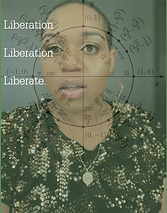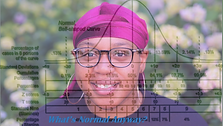The white gaze upon the Black soul is a simplified cartoon, filled with the loudest emotions and bright colors...
The white gaze upon the Black soul is a simplified cartoon, filled with the loudest emotions and brightest colors. While my first profession is student, my second is the-only-Black-person-in-the-room, and I have been at it for quite some time. For that reason, I am not simply existing with a race, but constantly surrounded with white gaze.
Some friends tell me they are interested in fried chicken and Sunday morning gospels as a way of experiencing the pleasures of Blackness. Others want to know Blackness as a sickness, with violent crime and low representation defining my race as a social problem. For this reason, I infer that my Black life has been interpreted as Saturday morning cartoon floating across a bright and fuzzy screen - vibrant, yet reduced to inconsequential meaning.
As mentioned before, there seems to be two cultural interpretations of Blackness: joy and violence. This is best shown by Black portrayal in the white-dominated media. Artists are sung heroes, those convicted are villains, and the rest of the community stands victim. The dangers of misinterpreting someone as one of the three stereotypes have taken lives. Many of the cultural oversimplifications have made their way into policy, algorithms, and any profession where white people eclipse.
The reason why the Black soul has been simplified is reliant upon what I call “silent racism.” Silent racism is fueled by white people talking amongst their own network for Black stories. This extends to other social groups, but for the sake of this essay, I will focus on the Black soul.
In a white glance of the Black soul, the average person may ask themselves for both sides of the story. Noticing how they tend to contradict their request and avoid interacting with those outside the community, I make the proposition that they have yet to listen to both sides. This leads to the question of who should tell the story? It seems a bit strange for a brown-skin narrative to have any of its parts told by white voice. Nonetheless, I digress.
Unfortunately, this is how history is told. Seeing information in textbooks omitted about Black Wall Street and the Black Panther’s People’s Free Food Program(“Tulsa’s ‘Black Wall Street’ Flourished as a Self-Contained Hub in Early 1900s - HISTORY,” n.d.). Many people don’t even know who the Black Panthers are and the ones that do were told that they were part of the villain category of Blacks(“The Most Important Legacy of the Black Panthers | The New Yorker,” n.d.).
Continuing this narrative that the Black soul has been grossly oversimplified, a large proportion of Black portrayal in the media is police brutality. From Sandra Bland, to Michael Brown, to Pittsburgh’s own teenage Antwon Rose, there hasn’t been a type of Black body omitted from police violence. While unarmed victims of police shootings have their names shouted in vigils and protests, the verdicts in cases silence them. Today, the word controversy is more associated with Black lives than civil rights. This silent racism is further complicated by the fact that little information is made publicly available, about race of police killing victims. In the Washington Post, 24% of unarmed victims are classified as “other” or “unknown.”(“2019 police shootings database - Washington Post,” 2019) While this information denames Black people who have identified with multiple races, it furthers silent racism.
There are many parts of Black history that have witnessed the white gaze. For example, the Black health movement in which the community has fought for better medical care by openly voicing concerns of bias in the face of doctors; built free clinics in which medical testing is provided to all; and educated itself on more nutritious food options as shown through social media hashtags such as #Blegan. Personally, I feel as if the Black health movement is the next leg of civil rights in America. It acknowledges the racism that has become invisible to the white gaze.
So what is the white gaze? One may wonder if it’s Toni Morrison’s interpretation of white people generically consuming Blackness(Greenfield-Sanders, 2019). In my definition, I reference white people viewing Blackness from a distance far enough where only the bright red flashes stand out. It is a distance too far to see invisible racism, which is a larger mix of beiges and earth tones, blending in with their cultural lifestyle. It is too far to hear the voices at normal volume talking about prejudice and injustice. It renders them silent, just as it is in the piece.
In order to acknowledge silent and invisible racism, the majority population will have to start paying attention to Black stories from Black people. This will require paying attention to emotional people.
Black health movement is the next leg of civil rights in America. It acknowledges the racism that has become invisible to the white gaze. So what is the white gaze? One may wonder if it’s Toni Morrison’s interpretation of white people generically consuming Blackness(Greenfield-Sanders, 2019). In my definition, I reference white people viewing Blackness from a distance far enough where only the bright red flashes stand out. It is a distance too far to see invisible racism, which is a larger mix of beiges and earth tones, blending in with their cultural lifestyle. It is too far to hear the voices at normal volume talking about prejudice and injustice. It renders them silent, just as it is in the piece.In order to acknowledge silent and invisible racism, the majority population will have to start paying attention to Black stories from Black people. This will require paying attention to emotional people.
J. Rene Canady
Part 2–The Process
For my sound collage, I decided to create a piece that narrates the white gaze in the Black Lives Matter Movement. Limited to just news stories, intense emotions, and church activists, this argument depicts the Black Lives Matter in an intentionally overstimulating fashion. While the simplicity of just announcing our racial existence as acceptable, we have already caused controversy to the community that isolates us most. To those involved, we here more than just gospel music-a prayer for things to end. A message to heaven asking, “What is the guidance the community must take to gain peace?” but before heaven can call back the message is intercepted by police in riot gear.
When the newscasters first float in the conversation, mention of officer injury is the first audible mention for the reader to interpret both causally and semantically(Chion, 1994). After is the song They that Wait by Fred Hammond, a very popular song for praise and worship. The gospel choir a soundmark of Black culture(Schafer, 1977). As the music continues, it becomes distorted along with the message, and soon the media takes hold of the listener. The praises of hopeful Christians fade out,andthe protests fade back in, symbolizing an underlying transition -theend of the “wait.”(Burke, 1968)
As we hear the Black Lives Matter protest go silent among the sound of three gunshots (the amount of times officer Michael Rosenfield, a former Pitt police officer, shot Antwon Rose in the back), the prayers switch from faith to grace. This is the religious cycle of the Black community, often coupled with action that has made the people resilient.
In the final part of the sound collage, gunshots play in the media and a person’s cries are faintly heard in the background. I intentionally added those sounds because the media has desensitized people to Black death. The newscaster speaks over the violence to suggest that it is just background noise. I believe that this piece successfully orients the listener to an environment in which they perceive Blackness in a distorted manner. Because when it comes to Black lives, there is assumption of nuance, similar to distortion of sound.
I would be interested in seeing both Black and White people both interacting with this piece.






